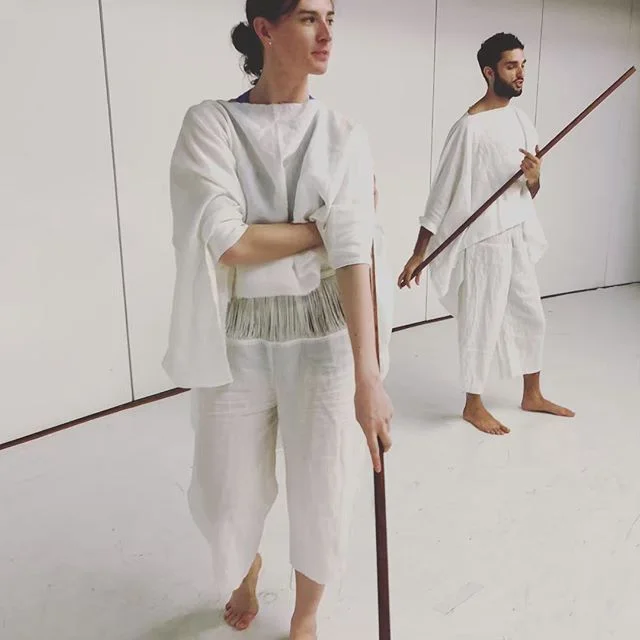Innovating Antiquity: Reid & Harriet at the Guggenheim
When asked about their attraction to the Ballets Russes, Reid Bartelme and Harriet Jung cited their initial perception of the company as an environment with a sense equity among collaborators, and the pleasure they derive from working on projects where they’re trusted with creative autonomy. Though further research during their NYPL fellowship proved that perceived equality to not always be the case, the question aptly contextualized Reid & Harriet’s Works & Process Guggenheim show, in collaboration with ISAW’s current exhibition, “Hymn to Apollo: the Ancient World and the Ballets Russes.” The design team commissioned two choreographers, Christopher Williams and Netta Yerushalmy (the former known for his interest in the ancient world, the latter for her project “Paramodernities,” which examines modernism in dance through deconstructing canonical works and pairing them with rigorous scholarship), to choreograph to Ravel’s “Daphnis et Chloé.”
pirate, image by Reid & Harriet
William’s excerpt—set to the second section of Ravel’s three part score—tells the portion of the story in which Chloé performs a “dance of supplication” and evokes of the creatures of Pan in attempts to escape from her capture by pirates. Reid & Harriet described William’s interest in controlling all aspects of the process, and their asserting agency over the costumes—an endeavor that proved most successful.
The choreography seemed constructed with the nature of the characters and their place in the overall story in mind, and read successfully: Chloé’s balletic choreography (danced by Sara Mearns) against the modern movement of the staff-wielding pirates heightened the desperation of her position, and dramatized the evocation of the creatures of Pan.
nymph, image by Reid & Harriet
In line with the Ballets Russes’ expansion of traditional male/female roles, the nymphs and pirates were both costumed without regard to gender: nymphs donned sheer nude unitards decorated with tufts of purple tulle, and the pirates’ white linen costumes consisted of cape-like tops and harem pants with a fringed waistband.
Chloé’s dress achieved a quality Ballets Russes designer Leon Bakst was known for, using a textile to mimic another, while allowing heightened range of motion. In this case, while the dress is reminiscent of silk, it is crafted from a form-fitting knit (eloquently described by Bartelme as “garbage fabric from the garbage store”). Her diaphanous scarf brought to mind those worn by Isadora Duncan, who inspired Bakst and Folkine by unleashing the idea that a ballet’s costumes could enable softness of movement, and Mearns, who channeled the dancer in last year’s “Dances of Isadora.”
creature of pan, image by Reid & Harriet
Bartelme and Jung used color and texture to delineate between various characters and worlds, evoking the Ballets Russes’ method of designating specific motifs for specific groups. The otherworldliness of the creatures of Pan was reiterated by their furry lilac knickers—their purple hue referenced their connection to Chloé and the nymphs, while the fabric’s texture (imagine an IKEA shag rug) clearly separated them from the human realm.
“like lithos” image by Eyrc Perez de Tagle via Reid & Harriet
Williams discussed his apprehension to cede control over the costumes, and how seeing Reid & Harriet’s interpretations of the characters enhanced his choreographic process. Yerushalmy, who began her process with certain elements (the music) already in place, worked more collaboratively on her piece’s costumes. She was interested in expanding on the movement and choreographic options afforded by a concept Reid & Harriet used in their last show at the Guggenheim, a black “silk kite.” Reid & Harriet also developed prints based off of abstracted elements (embellishments, details, etc.) of Ballets Russes costumes, which they printed onto fabric used for unitards worn underneath the “kites.”
“like lithos” unitard (1/4), image via Reid & Harriet
Yerushalmy cited the same liberation felt by Williams with regard to the predetermined constraints of her work, enabling an increased focus on the ISAW exhibition. She spoke of viewing the Ravel score as a “tapestry,” with an ability to flow in and out of the work; developing the geometry of her work (referencing Graham); and an interest in the visual impact of her dancers against a white background. “Paramodernities” abstracted what was to bring history to the present; “like lithos” applies the same diligence, but with heightened ephemerality and less strict adherence to a specific history and its vocabulary.
For more: ISAW’s “Hymn to Apollo” will be on view through June 2, and the Guggenheim’s Works and Process has uploaded the Monday evening performance to their YouTube account, here.







